Chapter 17- Pyruvate Dehydrogenase and the citric acid cycle
1/29
There's no tags or description
Looks like no tags are added yet.
Name | Mastery | Learn | Test | Matching | Spaced |
|---|
No study sessions yet.
30 Terms
Citric Acid Cycle
series of oxidation–reduction reactions that result in the oxidation of an acetyl group to two molecules of CO2
the final pathway for the oxidation of fuel molecules
oxidation generates high-energy electrons used to power ATP synthesis
important sources of precursors for biosynthesis
also called the tricarboxylic acid (TCA) cycle or Krebs cycle
Acetyl CoA
Most fuel molecules enter the citric acid cycle as acetyl CoA (acetyl coenzyme A)
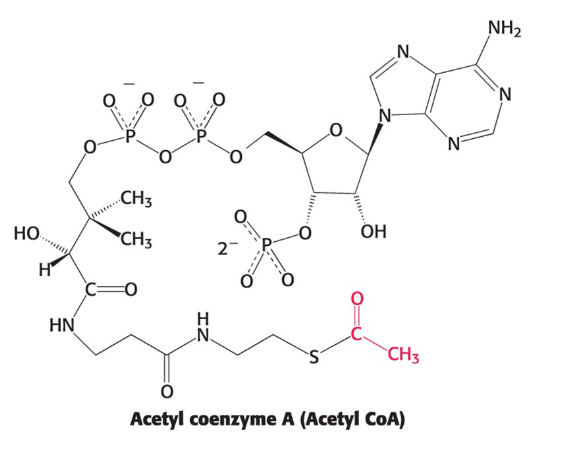
Pyruvate dehydrogenase complex
A large enzyme complex that oxidatively decarboxylates pyruvate to acetyl CoA under aerobic conditions
Acetyl CoA’s entrance into the citric acid cycle
Acetyl CoA enters the citric acid cycle where all remaining carbons are completely oxidized to CO2
Reactions to the pyruvate dehydrogenase complex and the citric acid cycle take place in the mitochondrial matrix
Structure of the mitochondria
Have distinct compartments defined by two membranes
In eukaryotes, the reactions of the citric acid cycle take place in the matrix of the mitochondria
Glycolysis takes place in the cytoplasm
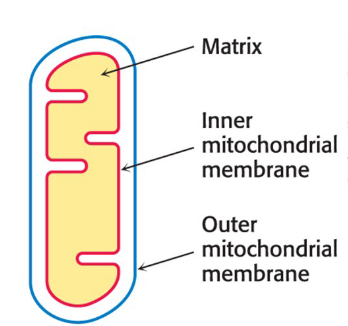
Overview of the citric acid cycle
The citric acid cycle removes electrons from acetyl CoA and uses the electrons to reduce NAD+ and FAD to form NADH and FADH2
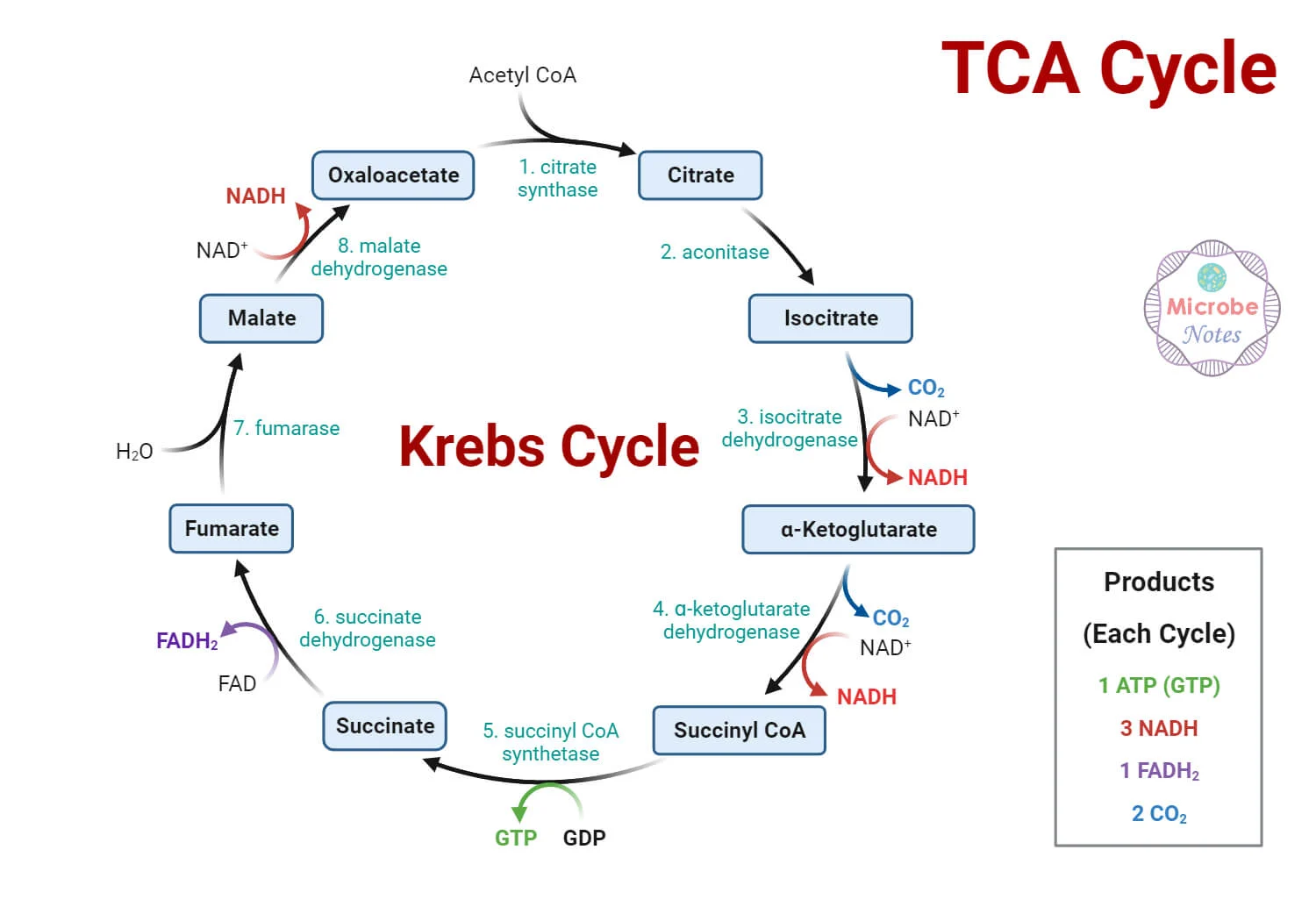
Electron-transport Chain
A series of membrane proteins that electrons released in the reoxidation of NADH and FADH2 flow through to generate a proton gradient across the inner mitochondrial membrane
Protons flow through ATP synthase to generate ATP from ADP and inorganic phosphate
How does citric acid connect to the elctron transport chain?
Cellular respiration removes high-energy electrons from carbon fuel molecules to generate ATP

How does the citric acid cycle connect to the electron transport chain?
Through pyruvate dehydrogenase
Pyruvate dehydrogenase complex: a highly integrated unit of three distinct enzymes in the mitochondrial matrix
oxidatively decarboxylates pyruvate to acetyl CoA
Pyruvate + CoA + NAD+ → acetyl CoA + CO2 + NADH + H+
Reaction catalyzed by the pyruvate dehydrogenase coomplex is an irreverisble link between glycolysis and the citric acid cycle
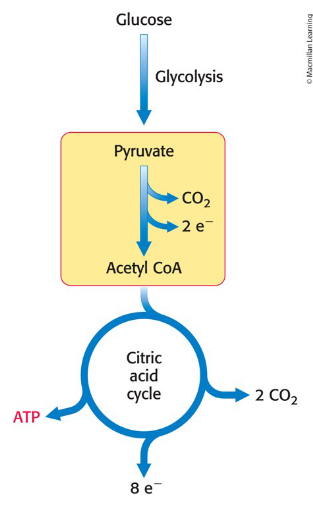
Conversion of pyruvate into acetyl CoA
Consists of three steps plus a regeneration step
steps must be coupled because the free energy from the decarboxylation step drives the formation of NADH and acetyl CoA
The catalytic cofactors are thiamine pyrophosphate (TPP), lipoic acid, and FAD
The stoichiometric cofactors (cofactors that function as substrates) are CoA and NAD+
Citric Acid cycle step 1
Citric Acid cycle oxidizes two-carbon units
Citric synthase catalyzes the addition of acetyl CoA and oxaloacetate, yielding citrate and CoA
reaction is an aldol addition and a hydrolysis
proceeds through energy-rich citryl CoA
Citric Acid cycle step 2
Mechanism of citrate synthease prevents undesirable reactions
it minimizes the hydrolysis of acetyl CoA to acetate and CoA side reaction
Citrate synthase exhibits sequential, ordered kinetics
oxaloacetate induces a structural rearrangement that creates an acetyl CoA binding site
Citric Acid cycle Step 3
Citrate is isomerized into isocitrate
iron-sulfur protein (nonheme iron protein) = protein that contains iron that is not bonded to heme
ex. aconitase
aconitase catalyzes the isomerization of citrate into isocitrate through a dehyrdation step and a hydration step
Citric Acid cycle step 4
Isocitrate is oxidized and decarboxylated to alpha-ketoglutarate
isocitrate dehydrogenase catalyzes the oxidative decarboxylation of isocitrate, forming α-ketoglutarate and the high transfer-potential electron carrier NADH.
proceeds through the unstable oxalosuccinate
CO2 is released from oxalosuccinate to yield α-ketoglutarate
Citric Acid cycle Step 5
Succinyl coenzyme A is formed by the oxidative decarboxylation of Alpha-ketoglutarate
The α-ketoglutarate dehydrogenase complex catalyzes the oxidative decarboxylation of α-ketoglutarate to succinyl CoA, yielding NADH.
Citric Acid Cycle step 6
A compound with high phosphoryl-transfer potential is generated from succinyl coenzyme A
succinyl CoA synthetase catalyzes the cleavage of a thioester linkage of succinyl CoA, yielding succinate
coupled to the phosphorylation of ADP or GDP because the ∆G°′ for the hydrolysis is comparable to that of ATP
The reaction is readily reversible
True or false: ATP or GTP formations may be coupled to the formation of succinate
True
Mammals have two isozymic forms of the enzyme
The GDP-requiring enzymes predominates in tissues performing anabolic reactions (ex. liver), and the GTP is used to power succinyl CoA synthesis
the ADP-requiring enzyme predominates in tissues performing large amounts of cellular respiration ex. skeletal and heart muscle
Citric Acid cycle step 7
Oxaloacetate is regenerated by the oxidation of succinate
Succinate dehydrogenase, fumarase, and malate dehydrogenase catalyze successive reactions of four- carbon compounds to regenerate oxaloacetate.
FADH2 and NADH are generated.
Once regenerated, oxaloacetate can initiate another cycle.
Citric acid cycle step 8
Succinate is oxidized to fumarate by succinate dehydrogenase
FAD is the hydrogen acceptor because the free-energy change is insufficient to reduce NAD+
Succinate dehydrogenase
is an iron-sulfur protein has the isoalloxazine ring of FAD covalently attached to a histidine side chain
is embedded in the inner mitochondrial membrane
is directly associated with the electron-transport chain
Citric acid cycle step 9
Fumarate is hydrates to L-Malate by fumarase
fumarase catalyzes the stereospecific trans addition of H+ and OH-, yielding only the L-isomer of malate
Citric acid cycle step 10
Malate dehydrogenase catalyzed the oxidation of malate, yielding oxaloacetate and NADH
∆G°′ is significantly positive
The reaction is driven by the use of the products: oxaloacetate by citrate synthase and NADH by the electron-transport chain.
Citric acid cycle net reaction
The two carbon atoms that enter each cycle as acetyl CoA are not the ones that leave as CO2 during the initial two decarboxylation reaction
Citric acid cycle produces high transfer-potential electrons, ATP, and CO2

Stoichiometry of the citric acid cycle
Two carbon atoms enter in the form of acetyl CoA, and two carbons leave in the form of CO2 molecules.
Four pairs of hydrogen atoms leave in four oxidation reactions (yielding three NADH and one FADH2).
One compound with high phosphoryl-transfer potential (usually ATP) is generated.
Two water molecules are consumed.
How many enzyme-catalyzed reactions make up the full citric acid cycle?
8
There is a physical association of the citric acid cycle enzymes into a supramolecular complex
allows for substrate channeling

Regulation of entry to the citric acid cycle and metabolism through it
The formation of acetyl CoA from pyruvate is irreversible in animal cells.
Acetyl CoA has two principal fates:
metabolism by the citric acid cycle
incorporation into lipids
The activity of the pyruvate dehydrogenase complex is tightly controlled allosterically and by reversible phosphorylation.
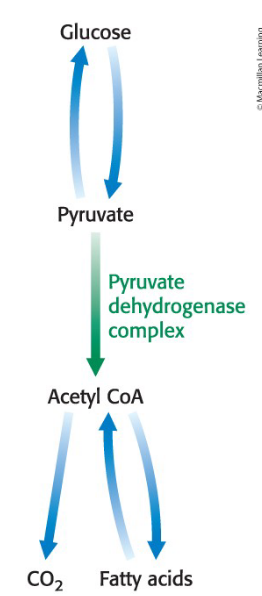
Pyruvate dehydrogenase complex is regulated allosterically- don’t need to know
High concentrations of reaction products inhibit the reaction by informing the enzyme that there is no need to metabolize pyruvate to acetyl CoA
Acetyl CoA inhibits the transacetylase component (E2)
NADH inhibits the dihydrolipoyl dehydrogenase (E3)
regulated by reversible phosphorylation
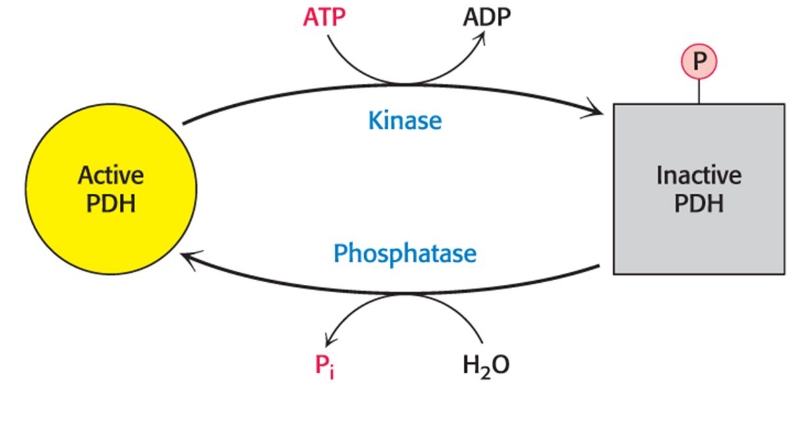
Regulation in biological conditions
At rest, the ratios of NADH/NAD+, acetyl CoA/CoA, and ATP/ADP are high
promotes phosphorylation and inactivation of the complex by activating PDK
during activity:
high ADP and pyruvate activate the complex by inhibiting the kinase
Ca2+ stimulates the phosphatase, enhancing the pyruvate dehydrogenase activity
Regulation in citric acid cycle
Regulated at several points
isocitrate dehydrogenase and α-ketoglutarate dehydrogenase are allosteric enzymes that primarily regulate the rate of cycling.
These are the first two enzymes that harvest high-energy electrons in the cycle.
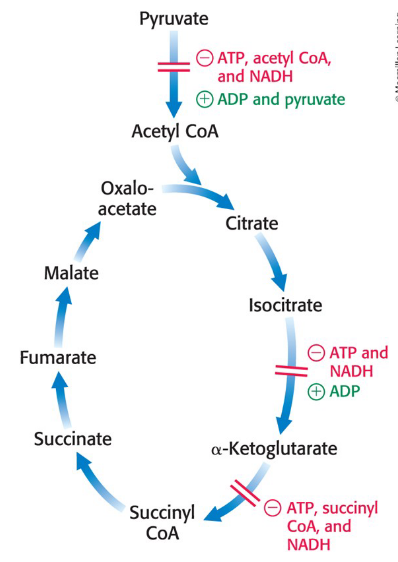
How is the citric acid cycle replenished if various components are consumed for other pathways?
Citric acid cycle intermediates must be replenished if any are used for biosyntheses.
ALWAYS NEED TO BE REPLENISHED**
Mammals lack the enzymes for the net conversion of acetyl CoA into oxaloacetate or other cycle intermediates.
anaplerotic reaction = a reaction that leads to the net synthesis, or replenishment, of pathway components
Pyruvate carboxylase catalyzes the formation carboxylation of pyruvate to oxaloacetate.
This reaction is used in gluconeogenesis and is dependent on the presence of acetyl CoA.
